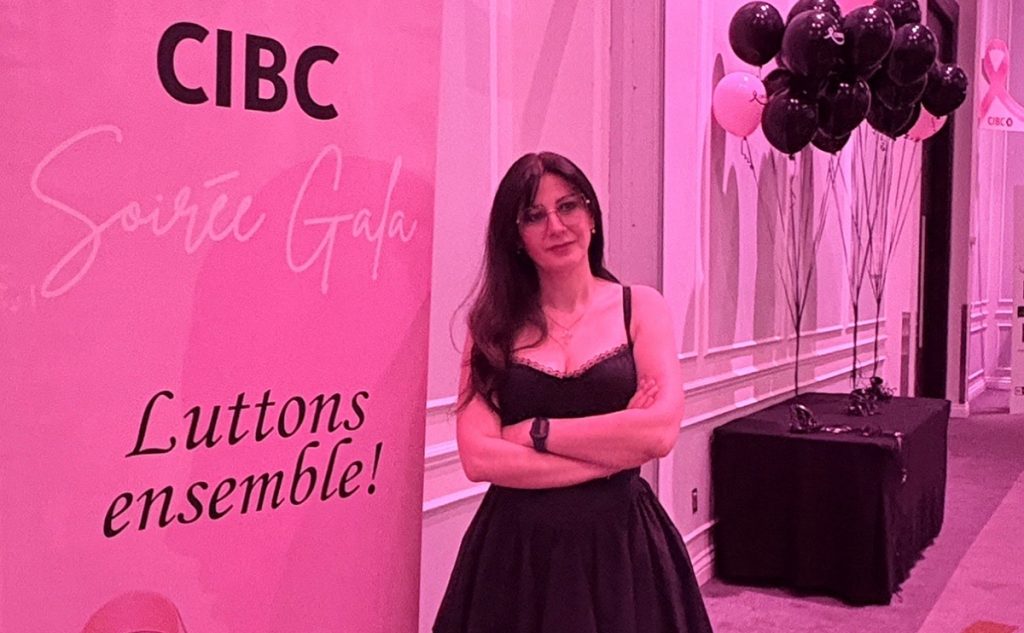Randa Hijazi is a contemporary Syrian-Canadian painter whose journey has carried her from Damascus to Dubai and finally to Laval, Quebec, where she has made her home since 2017. Born in Damascus, she graduated from the Faculty of Fine Arts at the University of Damascus in 2000. She later expanded her studies in Mass Communication and Media Science at the same university, graduating in 2008. This dual background—fine art and journalism—gave her a layered way of seeing the world. She can move between the sharp eye of a photojournalist and the open hand of a painter. Her paintings often carry this tension: documentary detail meets emotional resonance. Hijazi’s path through different cultures, landscapes, and struggles has shaped an art practice grounded in compassion and human resilience. In her work, color, symbol, and form are not just visual choices but ways of telling stories of pain, strength, and survival.
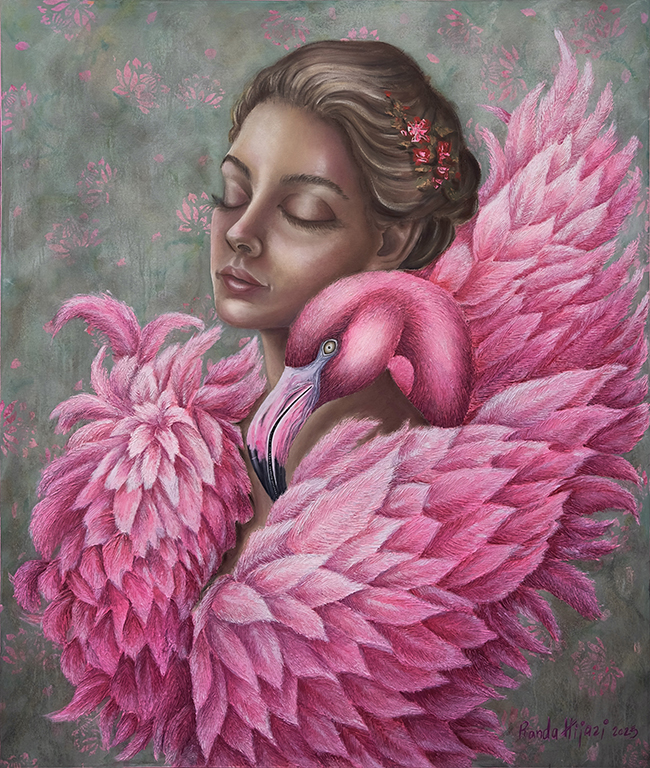
The Painting: Flamingo and Woman
The painting created live during the CIBC Bank gala in Laval exists both as performance and as artifact. In front of 450 people, Hijazi painted not only an image but an act of solidarity. The piece was part of her solo exhibition Let’s Fight Together, a show of 66 works dedicated to breast cancer patients. The painting was later auctioned, its value deepened by the shared moment of creation.
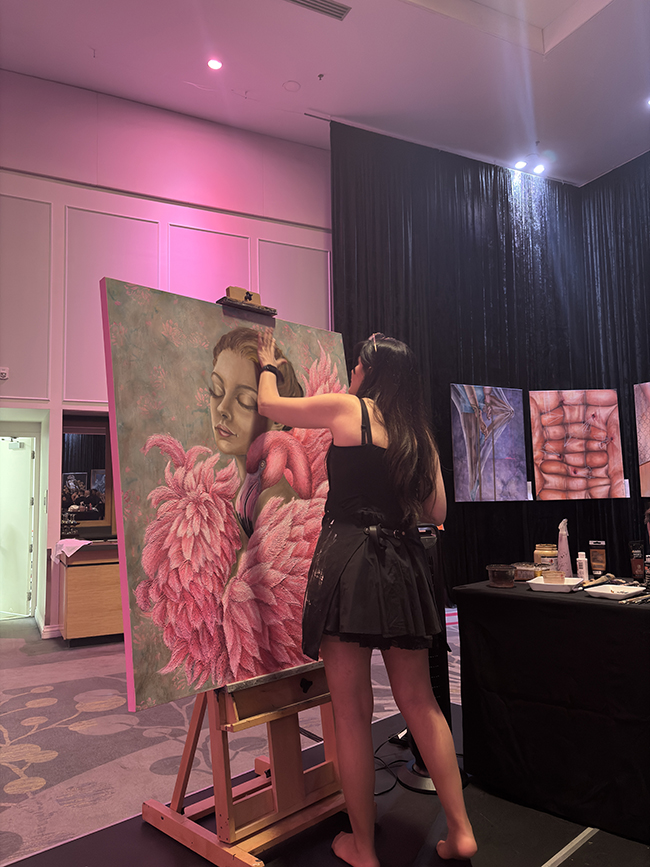
At the center of the canvas stands a woman, eyes closed. She is in pain, but her expression carries a quiet surrender, almost peaceful. Wrapped around her is a flamingo, its wings curved like a shield. The bird doesn’t simply perch or pose; it embraces. The pink feathers become both barrier and balm, transforming fragility into protection.
Hijazi’s choice of the flamingo is deliberate. The flamingo carries a weight of symbols. It is a creature of balance, standing firmly on one leg, poised between rest and action. This quality mirrors the woman’s battle—holding herself upright in the pull of illness, keeping balance between fear and hope. The flamingo is also a bird of beauty, with its unusual posture and radiant color. It reminds the woman of her own inner beauty, which illness cannot erase.
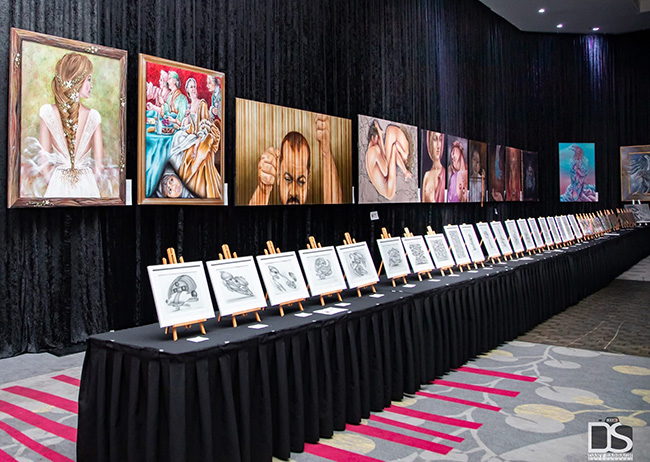
The bird is also known for loyalty, often choosing a partner for life. This detail echoes the human need for companionship through hardship. The woman does not stand alone. Around her are the invisible presences of partner, family, and friends—people who offer love, patience, and warmth when she falters. Hijazi brings this truth to the surface without painting them directly. The flamingo becomes a stand-in for human devotion.
Color plays its own symbolic role. The flamingo’s pink, shaped by what it eats, carries the idea of renewal. The body can change, weaken, even lose its form, but it can also return with new vitality. In this sense, the pink is not just pigment but metaphor for healing. Hijazi uses it to say: transformation is possible, even when the body suffers.
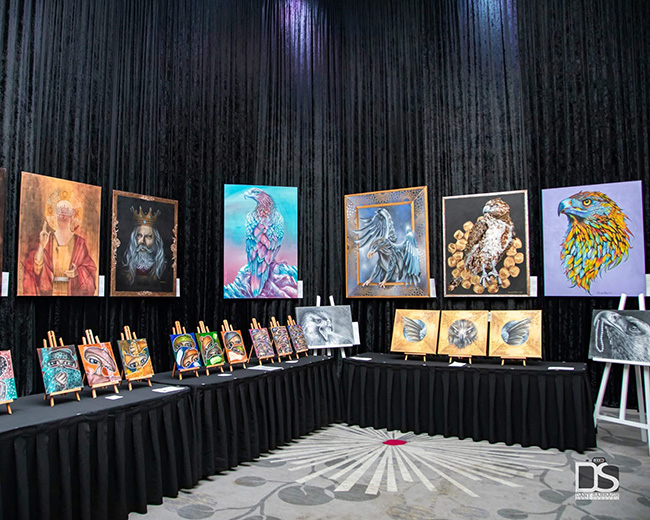
The painting reads almost like a dialogue. The woman closes her eyes as if listening to the bird. The flamingo bends toward her, as if whispering: You can still stand. You can still shine. This is not a scene of defeat. It is an image of endurance, of balance maintained in the most delicate moment.
What gives the work its strength is its simplicity. Hijazi does not crowd the canvas with excess detail. Instead, she focuses on gesture, symbol, and relationship. The result is a painting that feels soft and direct, carrying both vulnerability and resilience.
The public setting of its creation is also significant. To paint such an intimate image in front of hundreds of guests turned private pain into collective empathy. Each brushstroke became part of a performance of care, linking the individual story of a woman with the larger fight against breast cancer. The auction that followed reinforced this connection, transforming art into a means of raising support for patients.
In the end, the painting is more than an image of a woman and a bird. It is a story of survival told through symbol, color, and form. The woman carries qualities that mirror the flamingo: beauty, balance, loyalty, and renewal. Together they form a single figure of hope. The wings are not just feathers; they are faith, love, and the resilience of the human spirit.
Hijazi’s painting reminds us that even in pain, there is room for light. Even when standing on one leg, one can remain upright. And even in illness, there is a chance to rediscover color, to heal, and to shine again.

